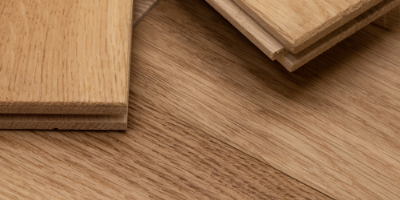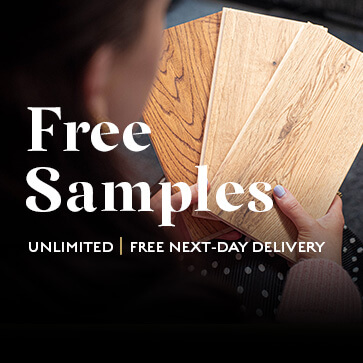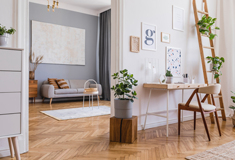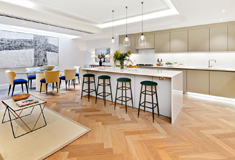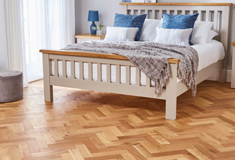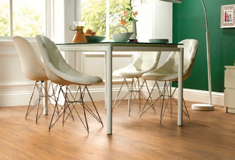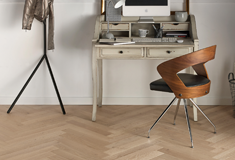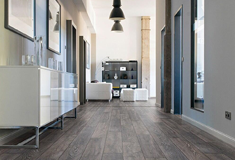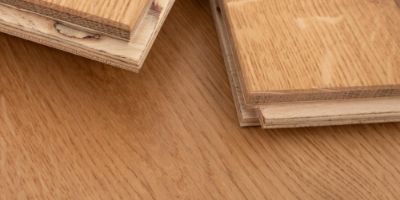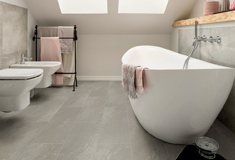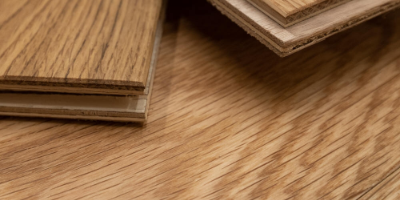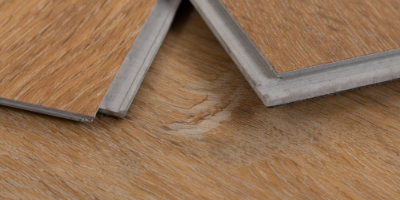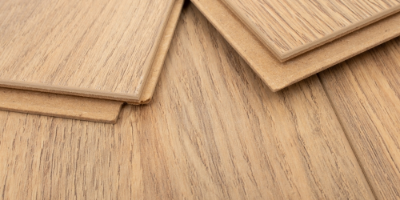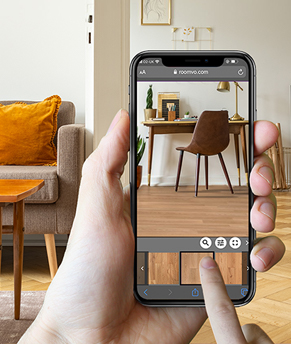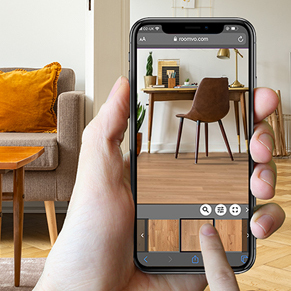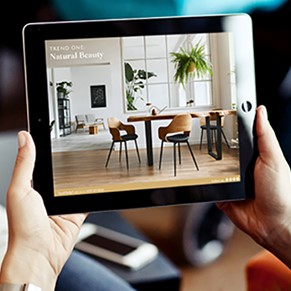Frequently Asked Questions
General Questions
After you've placed an order with us we'll keep you updated along the way. You'll get an email once your order is loaded for delivery and when you’re the next drop on the delivery route to help you plan. Your driver will also give you a quick call to let you know they’re heading your way. If you do have any more delivery questions, head over to our Delivery Information page.
Speedy deliveries are key; there’s nothing more annoying than waiting for weeks for a delivery. We deliver all our goods within 2-5 working days, however, if you’re not quite ready to receive your new flooring we can store your order in our warehouse for up to 3 months, for free.
When working out how much flooring to buy, it’s important to add on a bit extra. This is because each room is unique in its size and shape and often you’ll have to cut several boards to accommodate this. These cut boards are classed as ‘offcuts’ and the extra allowance is known as ‘wastage’.
We recommend adding 10% onto the amount of flooring needed for your room to cover your wastage allowance. To calculate this, simply multiply the total m² area of your room by 1.10 and you’ll have your answer!
Our limited edition products are just what the name suggests; floors that are only available for a limited time.
As limited editions aren’t part of our usual flooring collection, we only have a certain number of these floors available for sale and we can’t reorder them when we run out of stock. In other words, once they’re gone, they’re gone for good!
Solid and engineered wood flooring are natural products, so every plank will be slightly unique.
Colour variation between planks is completely normal, and if you’ve chosen a rustic grade floor, you’ll notice some natural knots and imperfections in the wood too. These will also vary from plank to plank and will give your floor a beautiful, aged look.
To get the best results from these natural variations, we recommend opening around 3 packs at a time and dry-laying your planks to create your desired look before you begin the installation.
If you’re having your new floor installed by a professional fitter, please let them know they’ll need to keep the natural variation of the planks in mind. This will ensure the different colours and imperfections are blended across the floor, giving you a gorgeous, authentic wood finish!
We’re happy to hear you’ve chosen to shop with us again. To make sure your new order matches up with the correct shade from your previous order, get in touch with our friendly sales team who will be able to help.
Solid Wood Flooring Questions
We would never advise our customers to install Solid Wood Flooring in a bathroom simply because Solid Wood Flooring would start to swell upon contact with a large amount of water. However, any pre-finished Solid Wood Flooring products can withstand any splashes and spills to an extent as the surface is water resistant.
No, Solid Wood Flooring is not suitable for use with underfloor heating.
When it comes to finishing our Solid Wood Flooring products, we make sure we apply multiple coats to strengthen the protection, making it extremely hard to scratch and chip.
Absolutely! We feel it is vital that our customers pick out their dream flooring, so we offer free samples on all of our Solid Wood Flooring products, allowing you to touch and feel the quality prior to purchasing.
When purchasing anything it is very important that the goods come with a warranty so you are protected from any manufacturing problems. Each product offers a different warranty which you can easily find on the specific product pages.
To prevent any creaks and squeaks it is very important you lay your Solid Wood Flooring onto an even subfloor. If the sub floor is not level, this can cause the flooring move and creak.
When it comes to installing a Solid Wooden Floor it is essential you leave at least a 10mm expansion gap, as this will allow the floor to breathe. As Solid Wood Flooring is a natural product you will get some slight movement (expansion and contraction), therefore an expansion gap is essential. A good way to cover up an expansion gap would be to use beading or skirting boards. This way the gap won't be visible to the eye.
The most highly recommended way to install a Solid Wood Floor is to stick the flooring directly down to a level sub floor using a wood flooring adhesive. On each of the product pages you can download a copy of the installation guide directly to your computer with one click.
Many companies will inform you that Solid Wood Flooring doesn't need much time to acclimatise, but we would always recommend our customers to allow a minimum of 120 hours (5 days) in the room the floor will be laid in. That way you can rest assured that your Solid Wood Flooring is 100% conditioned to be installed.
One of the main advantages of a Solid Wood Flooring product is the fact you can sand and refinish it multiple times, giving the flooring an extremely long life span. However, you shouldn't need to sand and refinish a Solid Wood Floor for the first 10 to 15 years. The idea behind sanding and refinishing a floor is so it looks as good as new.
Engineered Wood Flooring Questions
We would never advise our customers to install Engineered Wood Flooring in a bathroom simply because Engineered Wood Flooring would start to swell if it were to come into contact with a large amount of water. However, any pre-finished Engineered Wood Flooring products can withstand any splashes and spills much more effectivley as the surface is water resistant.
Yes, Engineered Wood Flooring is suitable for use with underfloor heating, but we advise that this does not exceed a temperature of 27 degrees celsius.
When it comes to finishing our Engineered Wood Flooring products we make sure we apply multiple coats which strengthens the protection, making it extremely hard to scratch and chip.
Absolutely! We feel it is vital that our customers pick out their dream flooring, so we offer free samples on all of our Engineered Wood Flooring products, allowing you to touch and feel the quality prior to purchasing.
When purchasing anything it is very important that the goods come with a warranty so you are protected from any manufacturing problems. Each product offers a different warranty which you can easily find on the specific product pages.
To prevent any creaks and squeaks it is very important you lay your Engineered Wood Flooring onto an even subfloor. If the sub floor is not level, this can cause the flooring move and creak.
When it comes to installing an Engineered Wooden Floor it is essential you leave at least a 10mm expansion gap, as this will allow the floor to breathe. As Engineered Wood Flooring is a natural product you will get some slight movement (expansion and contraction), therefore an expansion gap is essential. A good way to cover up an expansion gap would be to use beading or skirting boards. This way the gap won't be visible to the eye.
There are three main ways to install an Engineered Wood Floor. You can either glue it directly to the sub floor, nail the floor to the sub floor or lay the flooring as a floating floor. If you require detailed fitting instructions, each product page offers an installation guide which you can download directly to your computer with one click.
Many companies will inform you that Engineered Wood Flooring doesn't need much time to acclimatise, but we would always recommend our customers to allow a minimum of 36 hours (1.5 days) in the room the floor will be laid in. That way you can rest assured that your Engineered Wood Flooring is 100% conditioned to be installed.
One of the main advantages of an Engineered Wood Flooring product is the fact you can sand and refinish it multiple times, giving the flooring an extremely long life span. However, you shouldn't need to sand and refinish an Engineered Wood Floor for the first 10 to 15 years. The idea behind sanding and refinishing a floor is so it looks as good as new.
Laminate Flooring Questions
Laminate flooring is water resistant which means it can handle a reasonable amount of water - however, this doesn't make it 100% waterproof. The best option is always to clean/mop any spillages or leaks as quickly as possible.
Yes, laminate flooring is suitable for underfloor heating, but we recommend that this doesn't exceed a temperature of 27 degrees celsius.
The surface on top of laminate flooring products are extremely hardwearing and scratch resistant, so you needn't worry about pets for example damaging the surface.
Absolutely! We feel it is vital our customers pick out their dream flooring, so we offer free samples on the majority of our Laminate Flooring products, allowing you to touch and feel the quality prior to purchasing.
When purchasing anything it is very important that the goods come with a warranty so you are protected from any manufacturing problems. Each product offers a different warranty which you can easily find on the specific product pages.
To prevent any creaks and squeaks it is very important you lay your Laminate Flooring onto an even subfloor. If the sub floor is not level, this can cause the flooring move and creak.
As Laminate Flooring is not a natural product you don't have to leave an expansion gap around the room. You can simply lay the flooring up against the wall, however, we would always recommend finishing the flooring off with either some beading or skirting boards for a more complete look.
Laminate flooring simply just clicks together, making it very easy for any DIY fan or handyman. Fitting Laminate Flooring doesn't require an industry specialist, however if you do appoint one the job will be spot on.
Although this may differ depending on which company you ask, we believe it is best to give a minimum of 48 hours (2 days) for a laminate floor to acclimatise. This will ensure the best results and least risk. Make sure you put the flooring in the room it will be acclimatised in so it gets used to the correct conditions, and lay it flat so damage does not occur. You may stack packs if needed to save space.
Vinyl Flooring Questions
Luxury Vinyl Tiles (also known as LVTs) are individual tiles made from vinyl and backed with a layer of stone-based material, which makes them extremely durable.
LVTs are available in a range of colours and designs, including those that mimic the appearance of real wood and stone. This makes them a great affordable alternative to solid and engineered wood.
Vinyl tiles are made from multiple thin layers of PVC vinyl. Various compounds are applied to the PVC layers before they’re compressed and dried with a combination of heat and air. This creates a hard, resilient surface that will make up the base of the tile.
The top layer of vinyl is sometimes embossed with a pattern that mimics the grains and grooves found in real oak or stone.
Vinyl tiles are finished with a decorative layer and a protective coating to keep them looking their best.
The main difference between Rigid Core and SPC Vinyl flooring is the material they’re made from. Rigid Core is made from a combination of polymers, whereas SPC contains limestone and stabilisers, which creates a stronger protective core.
This means that while both types of vinyl flooring are highly durable, SPC vinyl offers a bit more impact resistance than Rigid Core.
Luxury Vinyl Tiles (LVTs) are extremely durable and resistant to scratches, spills and stains.
Many LVTs are designed to imitate real wood and stone, making them perfect if you want to achieve a natural look, but your budget won’t stretch to the real thing.
They are also available in a variety of patterns and styles and may feature colours that aren’t commonly found in wood floors such as white, grey, black and more. This means you’ll have a wider range of flooring options to choose from, if you opt for LVTs.
Yes, you can use underfloor heating with luxury vinyl tiles! Vinyl flooring is much thinner than wood, meaning the heat can transfer through the tiles quickly and easily.
While vinyl is sturdy enough to withstand fluctuating temperatures without warping, we do recommend checking the maximum temperature you can use with your underfloor heating. This will ensure you choose the right underfloor heating for your floor and avoid any mishaps!
Good news – LVT flooring is extremely low-maintenance and a breeze to clean!
Simply sweeping and cleaning your floor with a damp mop will keep it in tip-top shape. We recommend a quick sweep once or twice a week, depending on how quickly dirt and debris builds up in your home.
Any spills can be wiped away easily with a microfibre cloth.
There’s no need to wax or shine your LVT floor – in fact, doing this could damage its protective surface!
LVT is waterproof, slip-resistant and easy to clean, making it perfect for bathrooms and wet rooms!
Vinyl also feels much softer and warmer underfoot than stone or ceramic tiles and comes with a much lower price tag.
Yes, LVT is a great choice for kitchen flooring!
Kitchens are prone to splashes and spills, so you’ll need a floor that’s resistant to stains, as well as quick and easy to clean – just like LVT.
And if you’re thinking about underfloor heating, you’ll be happy to hear that it pairs perfectly with vinyl tiles.
Vinyl flooring is extremely hardwearing and when cared for properly it can last a long time.
How long your flooring lasts will depend on how much traffic it’s exposed to and how well you look after it.
However, all our LVT flooring comes with a 25-year warranty, so you can feel confident that it’s truly built to last.
Most of our LVT flooring comes with pre-attached underlay to help you get the best results.
Underlay will provide cushioning underfoot, reduce noise and offer insulation.
There's no need to add additional underlay to your subfloor, but if you choose to, make sure it’s specifically designed for use with LVT and is no thicker than 2mm. This is very important - if your underlay is too thick, your floor may crack, due to the excess pressure.
Vinyl flooring is built to be extremely hardwearing, so it’s unlikely to be damaged by everyday use, even after several years.
Scratch-resistant and waterproof, our LVT flooring has you covered, whether you’ve got kids and pets running amok or you’re entertaining at home.
Yes, you can glue the joints of your LVT flooring, although this isn’t essential.
We recommend waiting until your floor has been fully laid before considering whether gluing the joints is necessary. You may notice excess movement in your floor at this point (particularly with herringbone). If this happens, you can glue the joints at the outer edges of your planks to secure them.
Please note, our click-fit vinyl tiles should not be glued anywhere other than the joints. Please see our installation guides for full instructions.
Vinyl tiles can be laid on a variety of surfaces, including concrete, plywood or floorboards. You can even lay vinyl planks over existing linoleum, laminate or tiles.
However, it’s crucial to make sure your subfloor is clean, dry and level, no matter which surface you lay your flooring on.
All of our LVT flooring comes with a 25-year warranty to give you peace of mind that your floor will look great in your home for years to come.
Luxury Vinyl Tiles are known for being quick and easy to install, making them perfect if you fancy giving DIY a try!
Most of our LVTs feature a handy click-fit system that allows the planks to fit together neatly and ‘click’ into place.
You can find all the tools you’ll need for the job in our LVT installation guides.
There are several options for finishing the edges of your LVT floor.
Any expansion gaps around the edge of your floor can be covered with beading or skirting, which can be closely matched to the colour and finish of your floor.
If you have any expansion gaps in your doorway or there’s a difference in height between your new floor and the floor in your hallway or the adjacent room, our selection of door profiles has you covered!
All our vinyl floors are tested for VOCs to ensure they’re safe and non-harmful to consumers. They are within the threshold outlined by the UK and EU limit values for VOCs in flooring.
While it’s often used in the production of vinyl flooring, none of our SPC LVTs contain formaldehyde.

